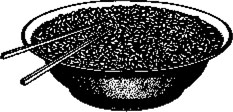
A Symbol of Life and Fertility for Centuries
Rice provides most of the food for more than half of the world’s human population. About 94% of the world’s rice is produced and consumed in Asia, where it is a symbol of life and fertility - hence the origin of the widespread custom of throwing rice at bridal couples! A member of the grass family, rice was cultivated in China as early as 27 centuries B.C., and in Japan it is so important that even the Emperor joins in its ritual harvest. More than 25 species of rice exist, but one species - Oryza sativa - furnishes virtually all of the world’s rice.
Rice Processing Destroys Many Nutrients
Losses of Nutrients when Brown Rice is Processed to White Rice*
| Nutrient | % Loss in White Rice |
| Protein | 11 |
| Fat (includes lipids/sterols) | 79 |
| Fiber | 67 |
| Calcium | 25 |
| Phosphorus | 57 |
| Iron | 50 |
| Potassium | 57 |
| Thiamin | 79 |
| Riboflavin | 40 |
| Niacin | 66 |
| Alpha-tocopherol (Vitamin E) | 84 |
Most people prefer white rice over brown. The only difference between the two is processing: Rice with the hulls removed but the bran left on is brown rice, whereas rice which is further processed (i.e. polished, “enriched”) is white rice. The nutritional value of rice is concentrated in the outer layers of the granule, which are rich in B-vitamins, vitamin E, minerals, fibre, and lipids and sterols such as gamma-oryzanol. Processing removes these layers, which are often sold as livestock feed. So while processing degrades the nutritional value of the human diet, at least it enriches the animal diet.
In rice-eating nations, 60-80% of calories come from rice. This means that 20-40% of calories from the other foods consumed must supply all the missing vitamins, minerals, and other important nutrients. In many countries, the nutrient content of rice largely determines the quality of health of the people who must subsist upon it. And white rice is not a nutrient-diverse food: 92% of a polished rice granule is solely carbohydrates, and only 2% of the additional material has any nutritional value.
The milling of rice has dramatic health consequences, the most important of which is the loss of thiamin (vitamin B1) responsible for beriberi among peoples whose diets consist almost entirely of white rice. Milling also decreases the content of riboflavin, niacin, protein, iron, and calcium in white rice. Brown rice, in contrast, retains its nutritional value.
Due to the industrialization of the Far East, Asian rice is now probably more processed than ever before in history. To put back some of the nutrients removed during processing, vitamins and minerals are sprayed on white rice, which ironically is then described as “enriched.” Vitamins and minerals are not the only nutrients stripped from rice during processing, but these are the only nutrients returned during “enrichment.” A significant amount of protein, fibre, and lipids and sterols are forever lost during the conversion of brown rice to white.